| |

Home
Thousands of tastings,
all the music,
all the rambligs
and all the fun
(hopefully!)



Whiskyfun.com
Guaranteed ad-free
copyright 2002-2023
|
 |
|
| Hi, this is one of our (almost) daily tastings. Santé! |
| |
|
| |
| |
October 9, 2023 |
|
  |
Four recent Port Ellen, vertically
There's not much more to add about Port Ellen, which we've already discussed so much here since 2002, a time when bottlers were already offering 'the very last casks'. So, it's been twenty-one years that numerous very last casks of this legendary Islay have been regularly offered to the thirsty masses (who were becoming increasingly affluent). We're certainly not complaining, but it does seem that there was quite a stockpile back in 2002, after all... Naturally, all four new Port Ellens that we'll try today are 'the very last drops' too, if not 'the rarest of the rarest of them all'. All good fun in any case, we totally love everyone who offers some new old Port Ellens anyway. Love, love, love, and love… |
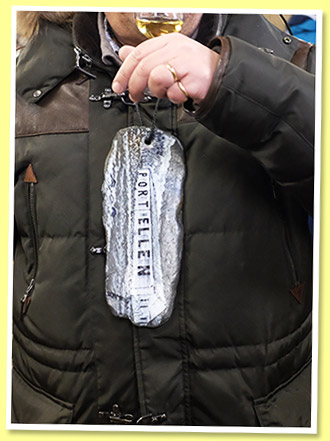
A few years ago, with some friends, we organised
a Port Ellen tasting in one of the last remaining
buildings still standing. As the definitive arbiter
of chic, I was sporting this very elegant and
discreet (yes, really) slate pendant in honour
of the then defunct little distillery.
(photo Marcel van Gils). |
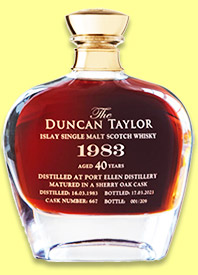
|
Port Ellen 40 yo 1983/2023 (52.4%, The Duncan Taylor, Rarest Collection, European oak sherry cask, cask #667, 209 bottles) 
This one from one of the last casks ever to be produced at the now 'old' Port Ellen Distillery, filled on March 16, 1983, aged on Islay until 2010, then moved to Duncan Taylor's premises in Huntly. Indeed, the 1983s have always been a little rare as the distillery was closed in May. I've often found them particularly excellent, as if Port Ellen had tried its very best before drawing the curtain. It's been the same at Brora, by the way. Colour: deep dark amber (there even was a wee fly, seriously!) |
Nose: oh sweet Vishnu. Would you mind calling the Anti-Maltoporn Brigade subito presto? Tarry balms, smoky ointments, fir liqueur, pistachios and bitter almonds, and this je-ne-sais-quoi that's very Port Ellen. Exquisitely rather balsamic – and empyreumatic - nose. With water: oh, old dunnage, cellar, moist hessian, eucalyptus, old paint, coal tar, lamp oil, a drop of turpentine… Mouth (neat): what power! Long story short, this is some mandarine marmalade, beefed-up with pepper, tar liqueur, a little seawater, black olives, cough syrup and, hold on, a drop of mezcal. Some splendid black-tobacco-y oak is bringing a perfect backbone without ever really getting in the way. With water: water is not necessary, but with just a few drops, smoked fruit liqueurs and jams would appear, especially peaches and, after 40 years, pears. In general, we'd rather find pears in young whiskies, don't you agree? Finish: medium, with some very balanced sherry, ashes and tobacco, old walnut wine and all those sorts of things. Old tar liqueur is always there. Smoke in the aftertaste, but it is not a peat monster (anymore?) Comments: so indeed, not a peat beast anymore, but on the other hand, it became wonderfully bituminous. Rather extraordinary.
SGP:465 - 95 points. |
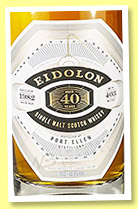
|
Port Ellen 40 yo 1982/2022 (56.5%, Eidolon by Hunter Laing, 2nd release, 403 bottles) 
It's been a long time since I've seen a new 1982, and in fact, I don't believe Diageo themselves have ever offered one, unless I'm mistaken. In any case, almost all the ones I've tasted were bottled in the 2000s, except for a few by the very distinguished Laing brothers. I remember a '1982 HL Kinship' had been particularly flabbergasting (WF 94). Colour: pale gold. Nose: this is more a classic old Port Ellen, with lemon oil, fumes, coal tar, old engine oil, new rubber boots and camphory embrocations. It is very immediate, it's almost instant love here. With water: sublime chalkiness. We're also reminded of an old oil lighter, like an old Zippo that's been used by several generations. Mouth (neat): dazzlingly fresh. Peppered citron juice, ginger tonic, black radish, seawater and all things tars and saps. With water: and voilà, clams and oysters, with a little tabasco and just pepper. Finish: very long, with some old pu-her tea now, tar candy, then some kind of smoky and mentholy honeyness… Candied kumquats in the aftertaste. Comments: it is a rather straighter one. Incredibly perfect at 40 years old, without the slightest sign of fatigue.
SGP:556 - 94 points. |
Hope we won't run out of laudatory adjectives and adverbs…. |
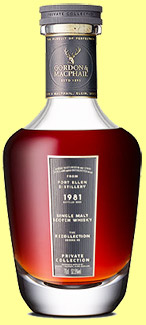
|
Port Ellen 42 yo 1981/2023 (52.5%, Gordon & MacPhail, The Recollection series #2, refill sherry butt, cask #290, 181 bottles) 
So, this one has been catching my eye on the shelves for many weeks, but I was waiting for a special occasion to taste it. I suppose a little vertical quartet like we're doing today is indeed a special occasion, isn't it? The colour itself is extraordinary and I cannot not think of some older (so younger, yep) light-sherried versions for Italy, most already from G&M's racing stable anyway. Colour: golden amber. Nose: plain smoky honey. More resins, balms, waxes, pollen. It's marvellous, and furthermore, it leaves the humble taster speechless, as it is so perfect and subtle. Please hide your disappointment. With water: mud and earth, old cellar, humidor, old attic, orange zests, notes of sweet and tart white manseng wine (say Jurançon)… This is more a Port Ellen for prestigious evenings in five-star hotels, rather than to take along in your silver hipflask (the one with a skull and a Harley logo). Mouth (neat): utterly masterful and extremely complex and rich, and yet never heavy. More balms and resins, a few sultanas, ripe mirabelles (when they get pink), grassier honeys, sweet spices… This time it is absolutely not a tar-bomb anymore, it's possibly one of the most civilised PEs I've ever tried. With water: it almost became a stunning herbal liqueur. Small citrus, lemongrass, plums, thyme, rosemary, woodruff, mint… Finish: medium, creamy and jammy, with all those stunning liqueurs and certainly bergamots, kumquats and other small citrus fruits. Honeyed aftertaste. Comments: all these Port Ellens are very different, but the quality remains constantly very high. In other words, there are obvious differences in style, especially since the peat is now fading a bit, but there is almost no difference in quality, thanks to the bottlers... and the distillers!
SGP:665 - 93 points. |
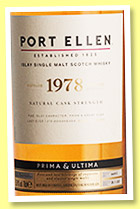
|
Port Ellen 43 yo 1978/2022 (53.4%, OB, Prima & Ultima Series #4, American oak hogshead, 413 bottles, 2023) 
This glorious bottle was just launched but it was bottled at the end of last year, in true (charming) Diageo fashion. Tell me about time to market issues in whisky! But I'm sure they do this to eliminate the bottle shock effect that occurs during and after bottling, the latter always being somewhat harsh unless done by delicate Scottish hands. Am I not right? By the way, the latest official 1978 we had tried, the 'Untold Stories' from 2018, had been absolutely superb. And we won't even mention the Rare Malts 20 and 22 that we'll probably try again soon, after around twenty extra-years of bottle aging (in general, 20+20=bingo). Colour: light gold. Nose: yet another style, subtler yet, lighter, more on 'smells of the woods', mosses, mushrooms, old stump at the bottom of a forest, then old magazines, damp cardboard and paper, old books and sauna oils (okay, reading an old book while taking a sauna), the tar is back too, but not as prominently as in the 1983. Add an old bottle of limoncello. With water: ooh, chalky earth, old fabric, old tweed, marzipan, fresh paint and fresh putty, coal tar, sea spray, our friends the whelks… Mouth (neat): more power on the palate, more lemon, more straight peat, more tar… In short, more Port-Ellenness. It feels almost young. With water: citron liqueur, bitter marzipan, oysters, drop of tar liqueur… Smoked oysters too, I believe they make that in lovely Taiwan. Finish: wonderfully fresh, pure; actually, it's the purest of them all. Comments: I wonder if the distillers, in the late 1970s, imagined that their production would be tasted and overanalysed like this by total amateurs, after more than forty years. And that it would be sold for, uh, a certain price.
SGP:566 - 94 points. |
By the way, my scoring method in a case like this, when the differences in quality are so tiny that the whole exercise might seem a bit pretentious, is: I write my notes, I give preliminary scores, then I revisit each of them in turn to further compare and thus refine the scores, which takes only a few seconds per whisky. In any case, there will be more Port Ellen before the end of the year, but we shall try to rather focus on younger versions that we've never tasted before. Unless a newer old one pops out in the meantime, naturally… |

|
|
Port Ellen wasn't that bad, afterall |
| There has always been a subset of whisky enthusiasts who used to believe, and perhaps still believe, that the distilleries closed by Diageo's predecessors in 1983 or slightly later (Port Ellen, Banff, Brora, Coleburn, Convalmore, Glenesk, Glenlochy, Glenury, Millburn, North Port, Glen Mhor, St. Magdalene and a few others) due to a global overcapacity linked to a drop in world demand, were chosen because the quality of their whiskies was inferior to others. Some even claimed that Port Ellen, for instance, was inferior to Lagavulin and Coal Ila, with its closure and almost complete demolition by its owners as shining evidence. But in reality, the reasons were more tied, after the oil crisis, to production and modernisation costs as well as to poor expansion possibilities if ever needed (land, access, environmental issues). Because the older and smaller the distilleries, the lower the yields and thus the higher the production costs! In a way, one could almost claim that the intrinsic quality of the malts produced by these antique distilleries was actually superior to others. After all, the best soups are made slowly, in old pots. And by the way, why would Diageo go to such lengths to replicate as precisely as possible the malts from the old distillery in the brand new Port Ellen, if its malts had been 'less good than others'? Peace! |
|
|
| |
|
|
|
|
|
|

